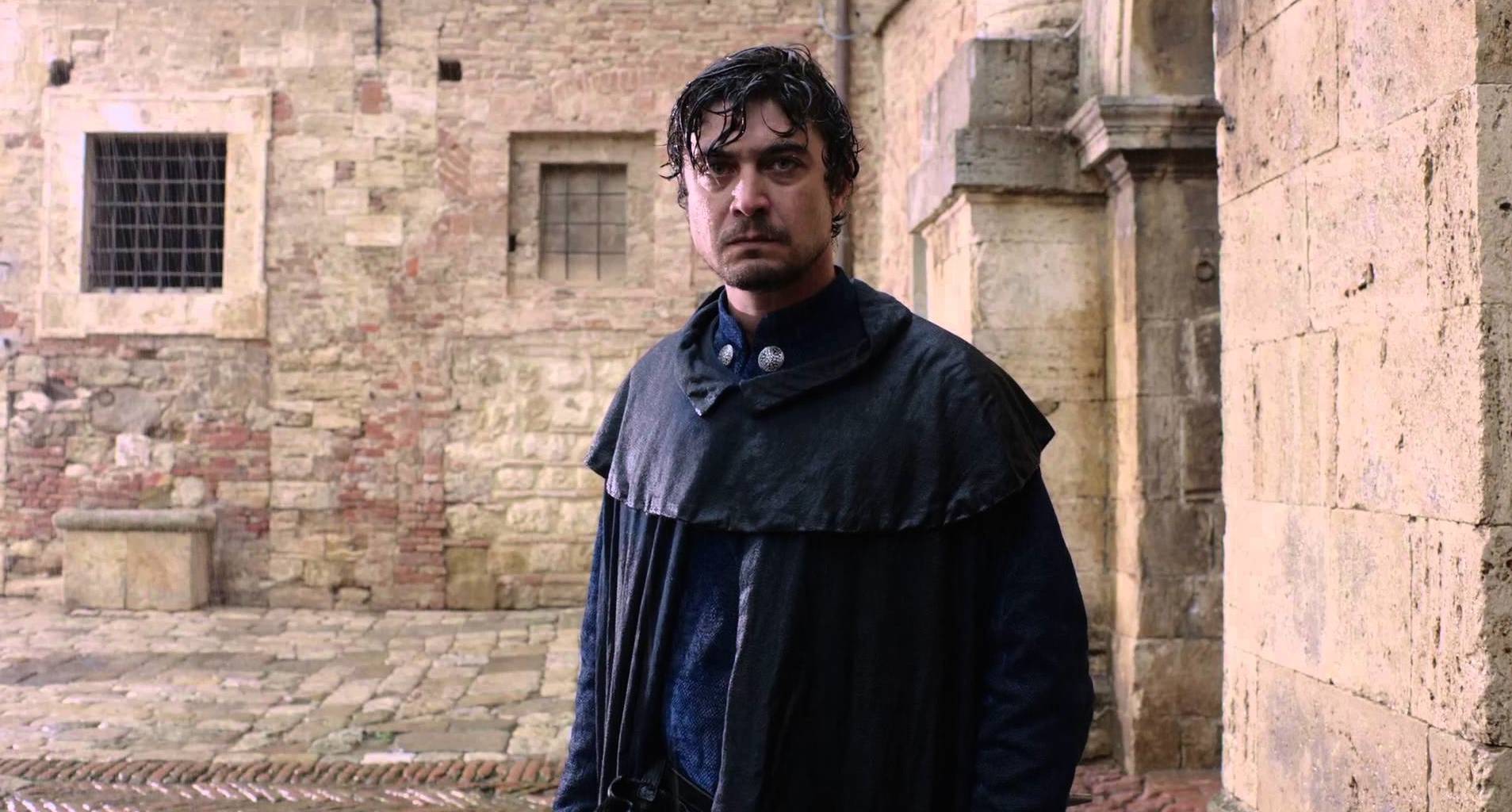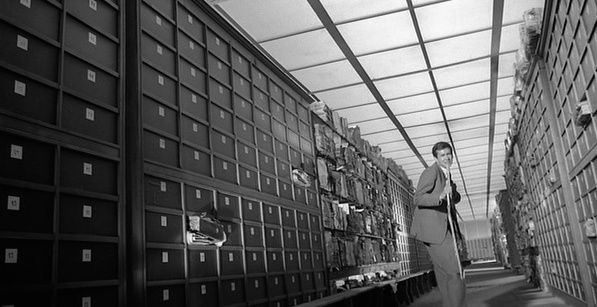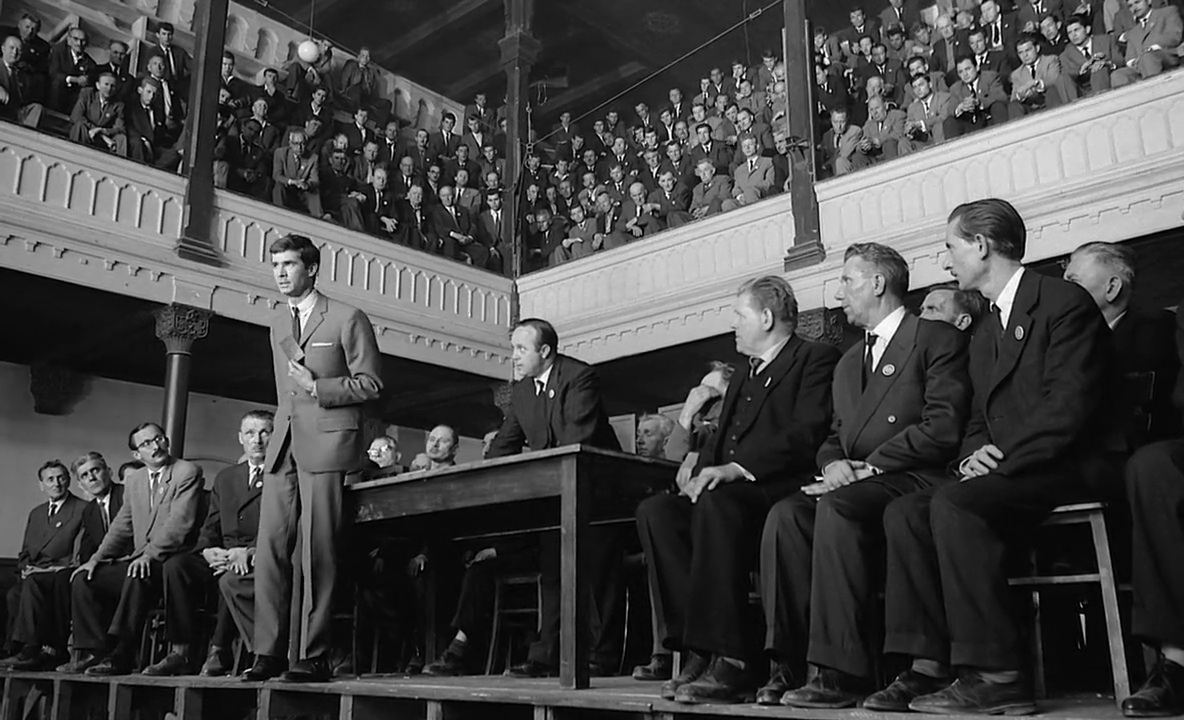[Editor’s note: This feature marks the fourth piece in an Orson Welles series celebrating the 100th anniversary of the filmmaker’s birth. See previous, “Orson Welles: The Enigmatic Independent, “The Orson Welles Bookshelf” and “Rosenbaum on Welles at 100.“]
Roberto Perpignani quite auspiciously made his official debut as professional film editor on Bernardo Bertolucci‘s feature debut Before the Revolution (1964). He went on to work with Bertolucci on The Spider’s Stratagem (1970) and The Last Tango in Paris (1972) and became the longtime editor for Paolo and Vittorio Taviani, a collaboration that begin in 1972 with St. Michael Had a Rooster. Perpignani won the David di Donatello Award (the Italian equivalent of the Oscar) for film editing three times, twice for Taviani films—The Night of the Shooting Stars (1982) and Caesar Must Die (2012)—and in between for the international hit Il Postino (1994). But it was Orson Welles that started his career as a film editor, first on In the Land of Don Quixote, a series of short documentaries that Welles made for Spanish TV, and then as one of his primary assistant editors on The Trial. Perpignani cut the film at a makeshift editing bay in the abandoned train station Gare d’Orsay in Paris, where Welles was shooting in another section of the station, and worked on the film practically up to its debut in the final weeks of December, 1962.
I had the great honor of meeting Perpignani when he came to Seattle to introduce a screening of Bertolucci’s The Spider’s Stratagem at the Seattle Art Museum, a 1999 event co-sponsored by the University of Washington. He graciously agreed to sit for an interview the next day. “I’m sorry my English is terrible today,” he remarked. “Worse than usual.” Perhaps, but it was certainly better than my Italian, and he had help translating some phrases and words from a professor of Italian Studies at University of Washington, who hosted the interview at his home. It’s with some embarrassment that I confess that in the years since I lost that man’s name, for he was essential in making this interview happen.
The interview was originally conducted for a project that was ultimately cancelled and it was never previously published. It debuts here more than fifteen years after it was conducted. Perpignani is still active as a film editor and his collaboration with the Taviani Bros. continues to this day. He edited their latest film, Maraviglioso Boccaccio (Wondrous Boccaccio), which premiered in Italy earlier this year and made its American debut at the 2015 Tribeca Film Festival.

Sean Axmaker: How did you get started as a film editor?
Roberto Perpignani: I went to art school and studied painting. I was a painter and then, when I was 20 years old, a friend of mine, Mariano Faggiani, asked me if I’d like to work with him for Orson Welles. And it was very strange because I never touched film before. Yes, I went to the Cine Club but nothing more. I knew [Welles’s] work. And I was not sure about doing it because my first interest was painting.
Axmaker: What did he do on the film?
Perpignani: He was working as an assistant editor. He started with Welles, too. It’s a very strange story of familia. Mariano was my sister’s son, and my sister was the same age as mother because it was my father’s second marriage and her son from a previous marriage. He was my nephew and he was three years older than me. His brother married Paola Mori’s sister, and Paola Mori was [Orson Welles’s] wife at the time.
Axmaker: So he was related to Orson Welles too.
Perpignani: It’s a condition for this story. The first step.
Axmaker: So you went to work as an editor without ever having cut film before?
Perpignani: Yes, And Mariano neither, he started three months before me. But as we were very interested in this job we learned very quickly. After ten days I was working in his cutting room, which was his own garage in his villa near Rome, he asked my friend to teach me to use the cutting table and I started like that. During the first ten days I was just putting [the film footage] in order, I didn’t have any serious duties. But then after ten days he asked Mariano to teach me the cutting table and I started to really work with him. He would mark the film and we had to cut it, to do the physical work. It was 1962 and I was twenty or so.
Axmaker: Was this the documentary In the Land of Don Quixote, which was a series for television?
Perpignani: Yes, ten or twelve documentaries about Spain.

Axmaker: And you worked on all of them?
Perpignani: No. They had already done a certain number of documentaries. They weren’t ready but the editing was already advanced. I worked for six months finishing them the documentaries and then he asked us to join him in Paris to work with him on The Trial, the film he made immediately after. We finished the documentaries while he was shooting The Trial and then we went to Paris with two cutting tables, his own cutting tables. They made a package deal. (Laughs.) And we worked on this film all the rest of the year. We finished the mix some days before Christmas.
Axmaker: How different was it editing The Trial than working on the documentaries?
Perpignani: Of course the film was quite different from the documentaries. Welles, in composing the documentaries, was looking for some ideas coming out of the footage. In the editing of The Trial, he knew perfectly what he was looking for, what he was composing, because he shot it with a very precise design. But in many, many cases, I saw that he was just looking for something very specific, different than anything he could think of before. There is a sequence for which we had a lot of material, a lot of footage. It was the moment when Mr. K arrives in the Hall of Justice and it’s full of people. [Welles] shot an enormous quantity of footage and we worked a long time composing the final version. There are other sequences that took much editing, with short shots, where the editing was very important. Sometimes the rhythm was internal, in the shot itself, and you didn’t have to edit. The camera, the actors, all the elements are moving. So it was a very different experience with this film.
Axmaker: When you would cut a sequence and Welles would look at it, would he make notes for you to re-cut the scene?
Perpignani: All the time. It was very rare that he was satisfied with the first cut. He was changing many times and I learned a lot this way because I saw that if you are looking for something, you have to do a very thorough job and look at everything you have, to understand, to discover. It’s something very important. I’m never afraid by the editing work because I learned from him that each time you start again on a sequence, you have the experience to reach for something different, more interesting. He would say, ‘Okay, now put this with this,’ and we would start again. Even when he didn’t tell us explicitly, we understood that he was trying for another effect. And sometimes later, coming back to a finished sequence, he would continue to make changes to improve it. It was a lesson in how to be creative and disciplined at the same time.
Axmaker: The film credits two editors—Yvonne Martin and Fritz Mueller—and I know that there were other uncredited editors who also worked on the film. How did you work with the other editors? Did you all work together or did you work on different sections?
Perpignani: Yvonne Martin was the French editor just because the film was coproduced and there was a French team of editors because they needed it for the coproduction, but they didn’t edit anything. They had just to edit a copy of the film. We would give them each reel to make an identical copy for France. They were paid by the producer, Mr. Salkind, and we were paid—not so much—as assistants of Mr. Welles. But the editing was done on our cutting table.
Fritz Mueller came on after. He was a very young editor at that time and he joined us at a certain moment because Mariano and I, we were not enough to resolve all of the problems. Fritz had more experience than us but not so much. He was the nephew—it’s another nephew (laughs)—of Renzo Lucidi, who was the editor of Mr. Arkadin, where Paolo Mori was the actress. So the nephew of Renzo Lucidi joined us in Paris. Also because the time came to start with the sound and Mariano and I, we did not have so much experience with sound. We were all assistants of Mr. Welles and Fritz was no more than us, but he was a young editor already and he asked the producer if he could be in the credits and Welles agreed. Mariano and I, we were not professional editors, we were just working for Welles, executing what he asked of us. But I have to say, each of us did the same work. No one of us could say that he was the editor of the film. No one except Orson Welles.
Axmaker: Did you work with Fritz?
Perpignani: No. Fritz did his work and I did mine. There was no particular feeling between Fritz and me. We did our own particular work but always our reference was Welles. Welles asked me, asked Fritz, asked Mariano to do something. We rarely had something to do with each other. Later Fritz Mueller joined Welles in Spain to edit Falstaff. Why not me? Because immediately after our work, I came back to Rome, looking for a job. But I wasn’t free when Welles was making Falstaff. I got married immediately after. I think that if I had been free I probably would have worked on Falstaff, but no one can say.
There was another thing. Fritz spoke English with Welles, and with me and Mariano, Welles spoke Italian. And this is not a little difference because I remembered that once Welles asked me why I didn’t do something and I told him ‘You didn’t tell me.’ ‘No, I told you.’ ‘No, you didn’t tell me because if you did, I would have done it.’ ‘No, I told you to do that.’ ‘No, you didn’t tell me.’ And we had an argument and I said, ‘Perhaps you told me in English and you know that I don’t know English. If you have to tell me something you have to speak Italian.’ It was very difficult because he was in front of me, coming on like that, and it I esteemed him so much. And it was very strange because after fifteen minutes we were working on the two different [editing] tables and he turned back and told me, ‘Roberto?’ I said, ‘Yeah?’ ‘Do you want a coffee?’ It was a very moving moment. Unbelievable! I was moved just now just thinking of it. (Roberto stops briefly, a little choked up) I can’t say he was generous, perhaps he was, but he was very rich [in character] and I received a very big experience. I didn’t know at the time what I was learning from him, I couldn’t say, but after I knew that I had learned much from him. Why? Because I discovered I was making the same gestures, I marked the film the same way he did. My way of working was coming from his way of working. I absorbed his way of working without realizing it and I’m very happy about that.
But I have to repeat that I was perfectly happy that it was Welles himself doing his own editing. It was a very special moment for him. He said somewhere in an interview, ‘I was very happy in the editing of The Trial, more than in the shooting.’ He felt that he was free to invent, free to look for, free to realize what he wanted. He was a very nice person but, as everyone knows, he was also very authoritarian. I never took it as an insult. We worked a lot, many times we only had four hours to sleep. I work all the time, a lot of hours by day. Before him, I was used to sleeping a lot. My mother couldn’t kick me out of bed. But after him it was unbelievable, it became normal to work day and night. I learned to sleep a few hours a day and I did that all my life.
Axmaker: Did Welles work that much too?
Perpignani: Yes, Welles was used to working a lot. He was unbelievable. His hotel was at the old train station [the Gare d’Orsay], where we had our cutting tables, and he was used to going up to his room, perhaps to take a shower, and coming back refreshed. But we weren’t. (Laughs.) Anyway, it was very interesting, because in one year I had an experience that was so big and so important and so intense, I don’t know how much time it would have taken to learn that much somewhere else.
Axmaker: You went on to work with some of the greatest directors in the world. You edited almost every film made by the Taviani Brothers. They must work very differently from Orson Welles, and from Bernardo Bertolucci. How would you describe working with those directors and being a creative part of their filmmaking process? With Welles you were executing his ideas, but with Bertolucci you had more freedom to try your ideas.
Perpignani: Bernardo asked me to share his intentions and to look for better solutions. I’m used to being a co-worker with directors and I’m very happy to interpret their intentions with my own contribution. It’s about working to find the right solution or give to the film something more than the director was thinking. I think that in front of the rushes, you can see something a little different than the way the director interpreted it. My way to work is never to just execute, except for Welles. I’m very happy it’s like that because I need the space to bring my own contribution to the film. That’s the reason I continue to be an editor. Also because, giving something you can receive something. With the Tavianis Brothers it was absolutely different with Bertolucci too. Our relationship is always different because we try to find our points of common connection. Bernardo and I, we are the same age. With Welles, he could be my father. But the Taviani Brothers are ten years older than me. They are brothers but they are not brothers with me. Bernardo and I were very close. When they told me I couldn’t go on working with him, they told me that we were friends and they needed an editor to correct his defects and I was too close with him. It’s a strange reason to send someone away because they are too close.
Axmaker: I hear so often that Orson Welles liked to work with young people. Why do you think that was?
Perpignani: You know, it’s life. He preferred young people. Also in that period he was working with young cinema students, in many cases they were twenty-two, twenty-four. I know he was looking for a certain kind of young assistant. The condition was the young man or woman had to be very interested and enthusiastic. He gave the young people reasons to be enthusiastic and he could drive them. I believed in what I was doing. And something very important, you give a lot if you receive a lot, and the young people who work with a person like him received a lot as a person. You learn not only to work, you learn the creative [side], you grow up.





